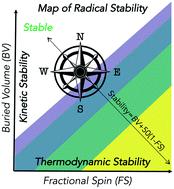当前位置:
X-MOL 学术
›
Chem. Sci.
›
论文详情
Our official English website, www.x-mol.net, welcomes your feedback! (Note: you will need to create a separate account there.)
A quantitative metric for organic radical stability and persistence using thermodynamic and kinetic features
Chemical Science ( IF 8.4 ) Pub Date : 2021-09-06 , DOI: 10.1039/d1sc02770k Shree Sowndarya S V 1 , Peter C St John 2 , Robert S Paton 1
Chemical Science ( IF 8.4 ) Pub Date : 2021-09-06 , DOI: 10.1039/d1sc02770k Shree Sowndarya S V 1 , Peter C St John 2 , Robert S Paton 1
Affiliation

|
Long-lived organic radicals are promising candidates for the development of high-performance energy solutions such as organic redox batteries, transistors, and light-emitting diodes. However, “stable” organic radicals that remain unreactive for an extended time and that can be stored and handled under ambient conditions are rare. A necessary but not sufficient condition for organic radical stability is the presence of thermodynamic stabilization, such as conjugation with an adjacent π-bond or lone-pair, or hyperconjugation with a σ-bond. However, thermodynamic factors alone do not result in radicals with extended lifetimes: many resonance-stabilized radicals are transient species that exist for less than a millisecond. Kinetic stabilization is also necessary for persistence, such as steric effects that inhibit radical dimerization or reaction with solvent molecules. We describe a quantitative approach to map organic radical stability, using molecular descriptors intended to capture thermodynamic and kinetic considerations. The comparison of an extensive dataset of quantum chemical calculations of organic radicals with experimentally-known stable radical species reveals a region of this feature space where long-lived radicals are located. These descriptors, based upon maximum spin density and buried volume, are combined into a single metric, the radical stability score, that outperforms thermodynamic scales based on bond dissociation enthalpies in identifying remarkably long-lived radicals. This provides an objective and accessible metric for use in future molecular design and optimization campaigns. We demonstrate this approach in identifying Pareto-optimal candidates for stable organic radicals.
中文翻译:

使用热力学和动力学特征的有机自由基稳定性和持久性的定量指标
长寿命有机自由基是开发高性能能源解决方案(如有机氧化还原电池、晶体管和发光二极管)的有希望的候选者。然而,长时间保持不反应并且可以在环境条件下储存和处理的“稳定”有机自由基很少见。有机自由基稳定性的必要但非充分条件是热力学稳定性的存在,例如与相邻 π 键或孤对键的共轭,或与 σ 键的超共轭。然而,单独的热力学因素不会导致自由基的寿命延长:许多共振稳定的自由基是存在时间不到一毫秒的瞬态物质。动力学稳定也是持久性所必需的,例如抑制自由基二聚或与溶剂分子反应的空间效应。我们描述了一种定量方法来绘制有机自由基稳定性,使用旨在捕获热力学和动力学考虑因素的分子描述符。有机自由基量子化学计算的广泛数据集与实验已知的稳定自由基物种的比较揭示了该特征空间中长寿命自由基所在的区域。这些基于最大自旋密度和埋藏体积的描述符被组合成一个单一的指标,即自由基稳定性分数,在识别非常长寿命的自由基方面优于基于键解离焓的热力学尺度。这为未来的分子设计和优化活动提供了一个客观且易于使用的指标。
更新日期:2021-09-16
中文翻译:

使用热力学和动力学特征的有机自由基稳定性和持久性的定量指标
长寿命有机自由基是开发高性能能源解决方案(如有机氧化还原电池、晶体管和发光二极管)的有希望的候选者。然而,长时间保持不反应并且可以在环境条件下储存和处理的“稳定”有机自由基很少见。有机自由基稳定性的必要但非充分条件是热力学稳定性的存在,例如与相邻 π 键或孤对键的共轭,或与 σ 键的超共轭。然而,单独的热力学因素不会导致自由基的寿命延长:许多共振稳定的自由基是存在时间不到一毫秒的瞬态物质。动力学稳定也是持久性所必需的,例如抑制自由基二聚或与溶剂分子反应的空间效应。我们描述了一种定量方法来绘制有机自由基稳定性,使用旨在捕获热力学和动力学考虑因素的分子描述符。有机自由基量子化学计算的广泛数据集与实验已知的稳定自由基物种的比较揭示了该特征空间中长寿命自由基所在的区域。这些基于最大自旋密度和埋藏体积的描述符被组合成一个单一的指标,即自由基稳定性分数,在识别非常长寿命的自由基方面优于基于键解离焓的热力学尺度。这为未来的分子设计和优化活动提供了一个客观且易于使用的指标。



























 京公网安备 11010802027423号
京公网安备 11010802027423号